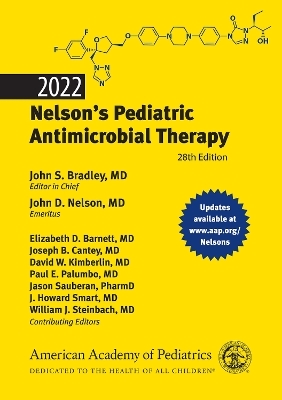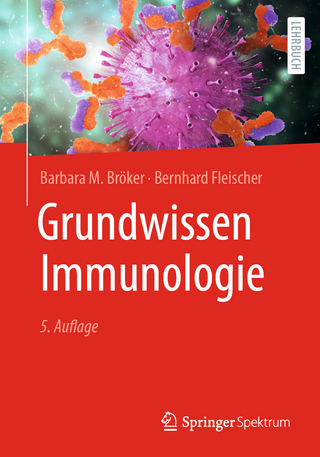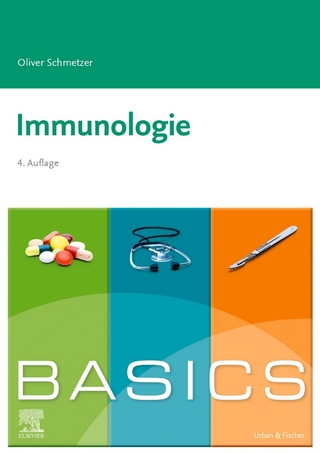
2022 Nelson's Pediatric Antimicrobial Therapy
American Academy of Pediatrics (Verlag)
978-1-61002-564-5 (ISBN)
Completely updated and revised, the 28th edition of this best-selling reference provides instant access to the latest recommendations for treatment of infectious diseases in children.
For each disease, the authors provide a commentary to help select the best of all antimicrobial choices. Drug descriptions cover all antimicrobial agents available today and include complete information about dosing regimens.
TOPICS INCLUDE
Antimicrobial Therapy by Clinical Syndromes
Antimicrobial Therapy for Neonates
Choosing Among
Antibiotics
Antifungal Agents
Antiviral Agents
Antiparasitic Agents
Oral Step-down Therapy for Serious Infections
Prevention of Symptomatic Infection
Approach to Antibiotic Allergies
Antibiotic Stewardship
New in the 28th Edition
Updated recommendations on acute hematogenous osteomyelitis, based on newly published guidelines by the Pediatric Infectious Diseases Society and the Infectious Diseases Society of America, including information on a decrease in the incidence of MRSA infections, allowing the recommendation of cefazolin, again, in empiric therapy for most pediatric bone infections
Updated recommendations on influenza treatment and prophylaxis, reflecting American Academy of Pediatrics guidance for 2021–2022
Ceftazidime/avibactam now preferred over fluoroquinolones for treatment of Klebsiella pneumoniae carbapenemase–producing enteric bacilli, if susceptible
Cefiderocol, a new iron-binding siderophore cephalosporin class, recently approved in adults for treatment of many drug-resistant pathogens, particularly Acinetobacter, Stenotrophomonas, and Pseudomonas; under study in children
New dosing for posaconazole suspension formulation
New approaches to mucormycosis
Added baloxavir for children 12+ years old
John S. Bradley, MD, FAAP has been the Medical Director of the Division of Infectious Diseases at Rady Children's Hospital-San Diego since 1988, and is currently Distinguished Professor of Pediatrics, Division of Infectious Diseases, Department of Pediatrics, University of California, San Diego School of Medicine. He has served on the American Academy of Pediatrics Committee on Infectious Diseases (Red Book Committee) 2004-2010, and the Council of the Pediatric Infectious Diseases Society (PIDS) Council, 2007-2011 where he promoted the development of a PIDS Antimicrobial Stewardship program. John D. Nelson, MD Emeritus is Professor Emeritus of Pediatrics at the University of Texas Southwestern Medical Center and Children's Medical Center, the same institution since he started his career back in 1957. At UT Southwestern he established the first formal Pediatric Infectious Disease fellowship program with Dr. Kenneth Haltalin and later Dr. George McCracken. He also went on to establish the National Pediatric Infectious Disease Seminar with Dr. McCracken and in 1982 they founded the Pediatric Infectious Disease Journal for which they continue as Chief Editors. In 1975 Dr. Nelson produced the first edition of the Pocket Book of Pediatric Antimicrobial Therapy which has gone through 20 biennial editions and is now edited by Dr. John Bradley. Joseph B. Cantey, MD, FAAP is an Assistant Professor of Pediatrics in the Divisions of Pediatric Infectious Diseases and Neonatology/Perinatal Medicine at the University of Texas Health Science Center in San Antonio. He attended medical school at the Medical University of South Carolina before completing his pediatric residency at Johns Hopkins. He then completed dual fellowships in pediatric infectious diseases and neonatal/perinatal medicine at the University of Texas Southwestern in Dallas, Texas. His research interests include antimicrobial stewardship and responsible prescribing in the nursery setting; infection control and prevention in the nursery setting; and the pathogenesis, diagnosis, treatment, and longitudinal follow-up of congenital and perinatal infections, particularly herpes simplex virus, cytomegalovirus, and syphilis. David W. Kimberlin, MD, FAAP, is the Editor of the 2021 AAP Report of the Committee on Infectious Diseases (Red Book). He also was Editor of the 2015 and 2018 editions, and was an Associate Editor of the 2012 and 2009 editions, and served on the AAP Committee on Infectious Diseases from 2005- 2011. Dr Kimberlin is Professor of Pediatrics and Co-director, Division of Pediatric Infectious Diseases, University of Alabama at Birmingham. His clinical and research interests include pediatric infectious diseases, antiviral therapeutics in rare diseases with a large unmet medical need, including neonatal herpes simplex virus (HSV) infections, congenital cytomegalovirus (CMV) disease, congenital Zika infection, neonatal and infantile influenza infection, and neonatal enteroviral sepsis syndrome. Paul E. Palumbo, MD is Professor of Pediatrics and Medicine at Geisel School of Medicine at Dartmouth College and Director, International Pediatric HIV Program at the Dartmouth-Hitchcock Medical Center. He specializes in pediatric HIV and TB disease. Jason Sauberan, PharmD is Assistant Clinical Professor at the University of California, San Diego, Skaggs School of Pharmacy and Pharmaceutical Sciences and a pediatric consultant pharmacist at the Helen Bernardy Center for Medically Fragile Children, Rady Children’s Hospital San Diego. His research interests include anti-infection therapy, drugs in breast milk, parenteral nutrition, and medication safety. He serves on the Scientific Advisory Board of Mother to Baby California, and is an assistant clinical professor, UC San Diego Skaggs School of Pharmacy and Pharmaceutical Sciences. J. Howard Smart, MD, FAAP has been practicing General Pediatrics in San Diego since 1996 after completing his residency, which included working with Dr. John S. Bradley at Children’s Hospital (now Rady’s) in San Diego. He is Chairman of the Department of Pediatrics at Sharp Rees-Stealy Medical Group and Assistant Clinical Professor of Pediatrics in the UCSD residents’ clinic. His involvement with Nelson’s started with a conversation with Dr. Bradley while flying to an AAP conference, discussing his hobby of mobile app development. Dr. Smart has been an app developer since 2011, and brings together the two knowledge domains of computer science and pediatrics in creating the mobile version of Nelson’s. William J. Steinbach, MD, FAAP is the Robert H. Fiser, Jr, MD, Endowed Chair in Pediatrics; Chair, Department of Pediatrics; and Associate Dean for Child Health at the University of Arkansas for Medical Sciences and the Pediatrician-in-Chief, Arkansas Children’s in Little Rock, AR. His expertise is in transplant infectious diseases, specifically in invasive fungal disease in children. He leads an integrated molecular, translational, and clinical research effort toward improving our understanding of invasive fungal disease epidemiology, diagnosis, and treatment.
Introduction
Notable Changes to 2022 Nelson’s Pediatric Antimicrobial Therapy, 28th Edition
1. Antimicrobial Therapy According to Clinical Syndromes A. Skin and Soft Tissue Infections
B. Skeletal Infections
C. Eye Infections
D. Ear and Sinus Infections
E. Oropharyngeal Infections
F. Lower Respiratory Tract Infections
G. Cardiovascular Infections
H. Gastrointestinal Infections
I. Genital and Sexually Transmitted Infections
J. Central Nervous System Infections
K. Urinary Tract Infections
L. Miscellaneous Systemic Infections
2. Antimicrobial Therapy for Neonates A. Recommended Therapy for Selected Neonatal Conditions
B. Antimicrobial Dosages for Neonates
C. Aminoglycosides
D. Vancomycin
E. Use of Antimicrobials During Pregnancy or Breastfeeding
3. Preferred Therapy for Specific Bacterial and Mycobacterial Pathogens A. Common Bacterial Pathogens and Usual Pattern of Susceptibility to Antibiotics (Gram Positive)
B. Common Bacterial Pathogens and Usual Pattern of Susceptibility to Antibiotics (Gram Negative)
C. Common Bacterial Pathogens and Usual Pattern of Susceptibility to Antibiotics (Anaerobes)
D. Preferred Therapy for Specific Bacterial and Mycobacterial Pathogens
4. Choosing Among Antibiotics Within a Class: Beta-lactams and Beta-lactamase Inhibitors, Macrolides, Aminoglycosides, and Fluoroquinolones
5. Preferred Therapy for Specific Fungal Pathogens A. Overview of More Common Fungal Pathogens and Their Usual Pattern of Antifungal SusceptibilitiesB. Systemic Infections
C. Localized Mucocutaneous Infections
6. Choosing Among Antifungal Agents: Polyenes, Azoles, and Echinocandins
7. Preferred Therapy for Specific Viral Pathogens A. Overview of Non-HIV, Non-hepatitis B or C Viral Pathogens and Usual Pattern of Susceptibility to Antivirals
B. Overview of Hepatitis B or C Viral Pathogens and Usual Pattern of Susceptibility to Antivirals
C. Preferred Therapy for Specific Viral Pathogens
8. Choosing Among Antiviral Agents
9. Preferred Therapy for Specific Parasitic Pathogens A. Selected Common Pathogenic Parasites and Suggested Agents for Treatment.
B. Preferred Therapy for Specific Parasitic Pathogens
10. Choosing Among Antiparasitic Agents: Antimalarial Drugs, Nitroimidazoles, Benzimidazoles, and Neglected Tropical Diseases
11. How Antibiotic Dosages Are Determined Using Susceptibility Data, Pharmacodynamics, and Treatment Outcomes
12. Approach to Antibiotic Therapy of Drug-Resistant Gram-negative Bacilli and Methicillin-Resistant Staphylococcus aureus
13. Antibiotic Therapy for Children Who Are Obese
14. Sequential Parenteral-Oral Antibiotic Therapy (Oral Step-down Therapy) for Serious Infections
15. Antimicrobial Prophylaxis/Prevention of Symptomatic Infection A. Postexposure Antimicrobial Prophylaxis to Prevent Infection
B. Long-term Antimicrobial Prophylaxis to Prevent Symptomatic New Infection
C. Prophylaxis of Symptomatic Disease in Children Who Have Asymptomatic Infection/Latent Infection
D. Surgical/Procedure Prophylaxis
16. Approach to Antibiotic Allergies
17. Antibiotic Stewardship
18. Systemic and Topical Antimicrobial Dosing and Dose Forms A. Systemic Antimicrobials With Dosage Forms and Usual Dosages
B. Topical Antimicrobials (Skin, Eye, Ear, Mucosa)
Appendix: Nomogram for Determining Body Surface Area
References
Index
| Erscheinungsdatum | 21.03.2022 |
|---|---|
| Mitarbeit |
Berater: Barnett Elizabeth, Joseph B. Cantey, David W. Kimberlin |
| Verlagsort | Elk Grove Village |
| Sprache | englisch |
| Maße | 121 x 171 mm |
| Gewicht | 308 g |
| Themenwelt | Medizin / Pharmazie ► Medizinische Fachgebiete ► Pädiatrie |
| Medizin / Pharmazie ► Medizinische Fachgebiete ► Pharmakologie / Pharmakotherapie | |
| Studium ► Querschnittsbereiche ► Infektiologie / Immunologie | |
| ISBN-10 | 1-61002-564-4 / 1610025644 |
| ISBN-13 | 978-1-61002-564-5 / 9781610025645 |
| Zustand | Neuware |
| Informationen gemäß Produktsicherheitsverordnung (GPSR) | |
| Haben Sie eine Frage zum Produkt? |
aus dem Bereich



